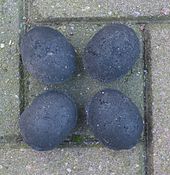briquette
The briquette is the result of briquetting , in which a raw material is shredded and pressed into a uniform shape using a briquetting press. If the shape is very small (less than approx. 2 cm in diameter), the pressing is called "pelletizing" and the product is called pellets .
history
Up to the end of the 20th century, briquettes made from lignite were the most common in the German-speaking area ; therefore the word “briquette” is often used colloquially as a synonym for “brown coal briquette”. Lignite briquettes are pressed under high pressure without a binder and are prismatic in shape. In the Rhineland , briquettes are known as " Klütten ". In the technical language of coal, there are also egg-shaped briquettes. These are made from ground coal , using coal tar pitch as a binding agent.
etymology

The French word briquette is the diminutive of brique = "brick"; likewise the Spanish la briqueta .
It is related to the English term brick for brick and the word break (including the break = the broken material). The name is said to have come into German in the 19th century as a joke name for the metal lunch box used by the Saarland miners ("shaped pressed coal").
Briquetting of coal
To produce briquettes from hard coal , the coal dust from the mine is first stored in a coal bunker. It is thrown into a dryer via a bucket elevator . Then it is mixed in a kneader at about 100 ° C with coal tar pitch finely ground in a pitch mill. After pressing in a punch press, a cooling process takes place.
If lignite is used, it is brought in pieces from the open pit to the bunker. In wet service, the coal is crushed, ground and classified. The coal is then dried and pressed into briquettes without any binding agents.
Compared to normal coal , cuboid briquettes have the advantage that, due to their regular shape, they can be put together or stacked well and easily and therefore only take up a relatively small amount of space. They are therefore now also stacked in packages, held together with tapes and, if necessary, sold shrink-wrapped in foil. Because of their small surface area compared to smaller pieces of coal and their high density, they hardly absorb moisture even when stored in a damp place. This is one of the reasons why they are a good fuel and were also used for locomotives and steamships in the past .
The oval nut and egg briquettes (egg charcoal) , which are made in roller presses , are only intended for domestic use . Hard coal dust , which is otherwise hardly usable (since coal dust- air mixtures can explode, transport is costly, e.g. in dust wagons ), can be easily recycled in this way.
Two German brown coal briquette brands are Union-Brikett (since 1904) and Lausitzer Rekord-Brikett .
Other briquettes
The same process is used with other solid fuels, most commonly wood. The pressing (briquetting) of wood produces wood briquettes . Much smaller pellets are called wood pellets . More rarely, briquettes are also made from plant residues or waste paper. However, these may only be incinerated in specially approved facilities.
In addition to fuels, ores , waste , scrap and animal feed are segmented and briquetted. This includes sponge iron , which - since the Iron Age and today largely industrially - is briquetted before further processing. The briquettes or pellets are an industrial component for gray cast iron from the cupola furnace or for steel production in the electric arc furnace .
A 3-inch Union briquette
Briquette filling on a street in 1991 in Naumburg (Saale)
See also
- Carl Exter (considered the inventor of the briquette press)
literature
- Adolf Gurlt: The preparation of the hard coal briquettes. With consideration for the conditions in Rhineland and Westphalia . Vieweg, Braunschweig 1880 ( digitized version )
- Maximilian Claudius Noack: Briquette factories - industrial centers of Lausitz. (P. 12–23) and briquette - the heavy energy package (p. 24–35). In: Sächsisches Industriemuseum - Lausitzer Bergbaumuseum Knappenrode and Vattenfall Europe Mining AG (ed.): Fiery stories - of ovens, fire and briquettes. Grossenhain 2004.
- Maximilian Claudius Noack: Briquette factories in the Lusatian lignite district. In: Museum der Westlausitz Kamenz (Ed.): Between Röder and Kleiner Spree, Issue 4, p. 40 51, Kamenz 2007.
- Hans Otto Gericke : wet molded bricks - wet pressed bricks - briquettes. From the early history of lignite molded bricks in Central Germany . In: Technikgeschichte, Vol. 67 (2000), H. 3, pp. 177-204.
Web links
Individual evidence
- ^ Brique (French). In: brique at the online dictionary Wortscheutung.info. July 22, 2019, accessed July 22, 2019 .
- ^ Brikett, das. In: Standard Verlagsgesellschaft mbH, Vordere Zollamtsstrasse 13, A-1030 Vienna. November 14, 2006, accessed July 22, 2019 .






